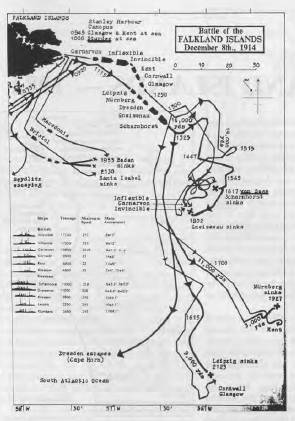- Author
- A.N. Other and NHSA Webmaster
- Subjects
- WWI operations
- Tags
-
- RAN Ships
- None noted.
- Publication
- March 1994 edition of the Naval Historical Review (all rights reserved)

Gallant to the last, Spee turned his two big ships to face his pursuers while ordering the three light cruisecs to make their escape. With their 12-inch guns and superior speed HMS Invincible and HMS Inflexible were able to wreak a terrible revenge on the Scharnhorst and Gneisenau, at a range of their own choosing. The flagship Scharnhorst sank at 1617 with her ensign still flying, and the Gneisenau followed her to the bottom at 1800.
The Nurnberg was chased by the armored cruiser Kent, which by a quirk of fate was the sister of the Monmouth. Any hope that the German ship had that her somewhat elderly opponent might not be able to keep up was dashed, for by heroic exertions the Kent’s stokers enabled her to exceed her designed speed. Another sister, HMS Cornwall brought the Leipzig to bay, sinking her at 2035, just over an hour after the Nurnberg.
Although SMS Dresden escaped the slaughter, it was the end of the German East Asian Squadron, with the death of von Spee and a large part of his devoted crews. The victorious British cruisers scoured the islands of Tierra del Fuego looking for the Dresden for another three months, and finally her old enemies the Glasgow and Kent trapped her, finding her sheltering in Chilean waters at Mas Afuera. Matching her abuse of Chilean neutrality, they steamed close in and forced her to scuttle to avoid capture.





